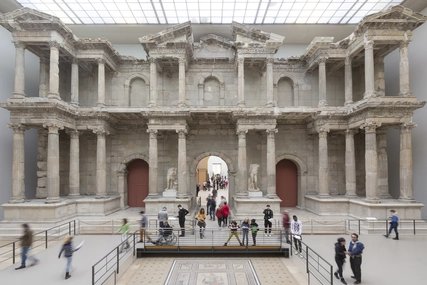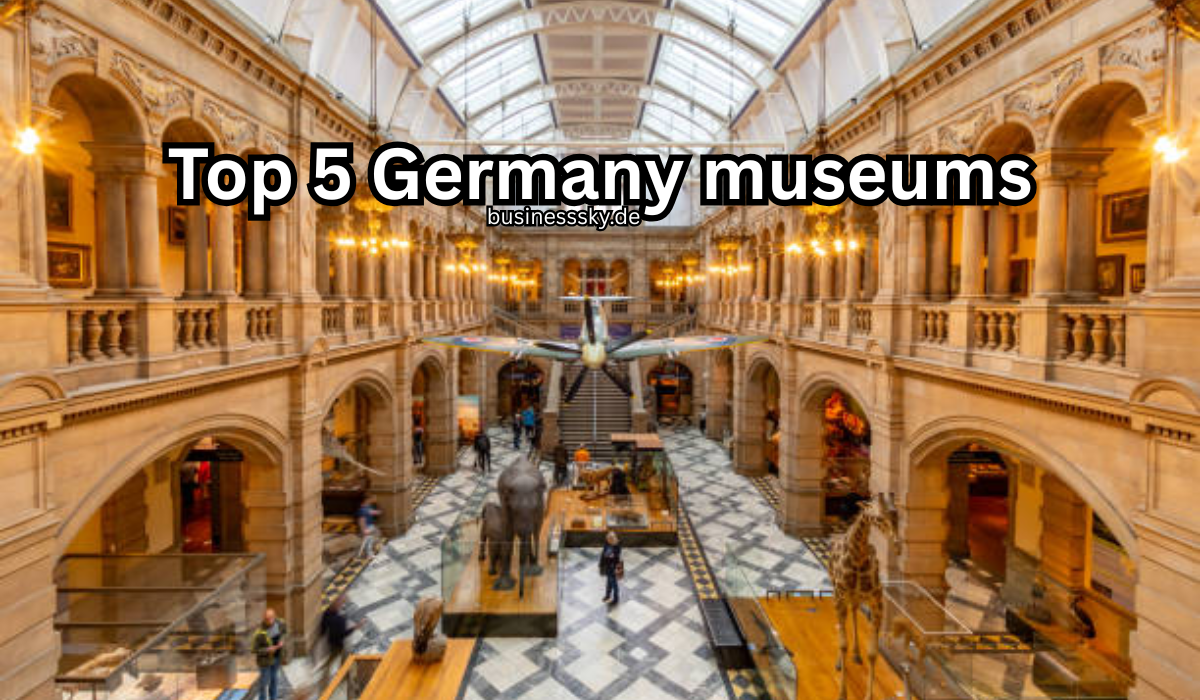Explore the Top 5 Germany museums for art, history, science, and more. Your complete 2025 guide to Berlin, Munich, Frankfurt, and Stuttgart museums.
Introduction
Germany, a land rich in culture, innovation, and artistic heritage, offers an incredible selection of museums for every kind of traveler. Whether you’re captivated by ancient civilizations, passionate about fine art, or fascinated by cutting-edge technology, Germany’s museum scene delivers a world-class experience. But with hundreds of options, which ones truly stand out?
The top 5 museums in Germany are the Pergamon Museum in Berlin, Neues Museum in Berlin, Deutsches Museum in Munich, Städel Museum in Frankfurt, and the Mercedes-Benz Museum in Stuttgart. These museums represent Germany’s finest achievements in archaeology, art, science, and industrial design.
In this comprehensive guide, we’ll explore these top 5 German museums in depth—covering what makes each unique, tips for visiting, comparisons, and answers to common questions. If you’re planning a trip or curating a cultural bucket list, this article is your ultimate resource.
Why Germany’s Museums Are World-Renowned
Germany is home to over 6,000 museums. From Berlin’s Museum Island—a UNESCO World Heritage Site—to interactive science halls and automobile showcases, these institutions reflect the country’s dynamic blend of tradition and modernity. Travelers come from around the globe to experience firsthand the art, science, and historical artifacts housed in these revered spaces.
1. Pergamon Museum, Berlin
A Monument to Ancient Civilizations
Located on Berlin’s famous Museum Island, the Pergamon Museum is Germany’s crown jewel of archaeological exhibitions. It’s one of the most visited museums in the country—and for good reason.
Highlights:
-
Pergamon Altar: A massive, awe-inspiring structure from the 2nd century BC.
-
Ishtar Gate of Babylon: A reconstructed, blue-glazed gateway that once led to the ancient city of Babylon.
-
Market Gate of Miletus: A Roman architectural marvel built in the 2nd century AD.
Practical Tips:
-
Buy tickets online to skip long queues.
-
It’s under partial renovation—check the official Staatliche Museen zu Berlin website for current access info.
Ideal For:
History lovers, architecture buffs, and travelers curious about the ancient world.

2. Neues Museum, Berlin
Home of Nefertiti and Prehistoric Wonders
Just steps away from the Pergamon, the Neues Museum is a must-visit for fans of Egyptian and prehistoric history. It reopened in 2009 after extensive renovations and has since been a global sensation.
Highlights:
-
Bust of Nefertiti: Arguably one of the most famous sculptures in the world.
-
Egyptian Museum and Papyrus Collection: Rare papyrus scrolls and mummies.
-
Prehistory and Early History exhibitions showcasing Neanderthal artifacts and Bronze Age tools.
Practical Tips:
-
Combo tickets for Museum Island offer better value.
-
Arrive early to avoid crowds near the Nefertiti exhibit.
Ideal For:
Art history students, cultural tourists, and fans of Ancient Egypt.

3. Deutsches Museum, Munich
The Largest Science and Technology Museum in the World
If you’re traveling with kids or are a technology enthusiast, the Deutsches Museum is an unmissable stop in Munich. It spans everything from astronomy to AI.
Highlights:
-
Aviation and Space Travel Exhibits
-
Early Computers and AI Evolution
-
Interactive science stations where kids can conduct experiments
Practical Tips:
-
Wear comfortable shoes—the museum is vast!
-
Use the official Deutsches Museum website to check what’s currently on display, as some sections rotate.
Ideal For:
Families, STEM students, and anyone who loves innovation.

4. Städel Museum, Frankfurt
Seven Centuries of European Art
One of the oldest and most prestigious art museums in Germany, the Städel Museum offers an extraordinary collection from the Middle Ages to contemporary works.
Highlights:
-
Works by Rembrandt, Vermeer, Monet, Picasso, and Gerhard Richter
-
A beautifully curated digital exhibition space
-
Temporary exhibitions that rotate throughout the year
Practical Tips:
-
Consider using the Städel app for self-guided tours.
-
Visit in the morning for a more tranquil experience.
Ideal For:
Art connoisseurs, students, and those seeking a quiet, reflective afternoon.

5. Mercedes-Benz Museum, Stuttgart
The Pinnacle of Automotive Storytelling
Automobile lovers, rejoice. The Mercedes-Benz Museum in Stuttgart isn’t just about cars—it’s about design, innovation, and Germany’s industrial history.
Highlights:
-
160+ vehicles on display, from the first car ever built to modern Formula 1 models.
-
History meets technology: Learn how world events shaped automotive design.
-
Interactive exhibits and immersive storytelling
Practical Tips:
-
Get combo passes with the Porsche Museum.
-
Check for special exhibitions or classic car meetups.
Ideal For:
Car enthusiasts, engineers, and those interested in industrial design.
;Crop,rect=(0,0,1680,945))
Comparison Table: Top 5 Museums in Germany
| Museum | City | Specialty | Ideal Visitor |
|---|---|---|---|
| Pergamon Museum | Berlin | Ancient Civilizations | History Buffs |
| Neues Museum | Berlin | Egyptian & Prehistoric | Art History Fans |
| Deutsches Museum | Munich | Science & Technology | Families, STEM Lovers |
| Städel Museum | Frankfurt | European Art | Art Enthusiasts |
| Mercedes-Benz Museum | Stuttgart | Automotive History | Car Fans & Engineers |
Practical Tips for Visiting Museums in Germany
-
Plan Ahead: Many museums have time slots and require advanced reservations.
-
Combo Passes: Look for regional museum passes (like the Berlin WelcomeCard).
-
Language: Most major museums offer English descriptions, but downloading an app or guide helps.
-
Photography: Check the museum’s policy—some allow photography without flash.
Best Time of Year to Visit
The best time to visit German museums is during the shoulder seasons—spring (April–June) and fall (September–October). Tourist crowds are thinner, and indoor attractions like museums are perfect for Germany’s mild and sometimes unpredictable weather.
FAQs About Visiting the Top Museums in Germany
1. Are the museums in Germany English-friendly?
Yes, most major museums have English signage, audio guides, and English-speaking staff. Some even offer apps for multilingual tours.
2. Is it cheaper to buy museum tickets in advance?
Often, yes. Buying online can give you discounts or priority access, especially at popular places like the Pergamon Museum.
3. Can I visit all Berlin museums in one day?
Not effectively. While Museum Island museums are close together, each deserves at least 2–3 hours. Spread visits across two days for a richer experience.
4. Which museum is best for kids in Germany?
The Deutsches Museum in Munich is excellent for children, thanks to its interactive exhibits and family-friendly layout.
5. Are German museums free on certain days?
Some offer free or reduced admission on specific days or evenings. Check each museum’s official website before visiting.
Conclusion
Top 5 Germany museums, From ancient altars and Egyptian queens to mind-blowing machines and modern art, the top 5 museums in Germany showcase the nation’s deep-rooted appreciation for culture, history, and progress. Whether you’re traveling through Berlin, Munich, Frankfurt, or Stuttgart, make room on your itinerary to step into these cultural powerhouses.
Ready to explore Germany’s museums? Book your tickets in advance, plan your city stops, and immerse yourself in one of the most culturally vibrant countries in Europe.
Read also: lothar matthäus’ sohn verstorben Family Insights Explained





